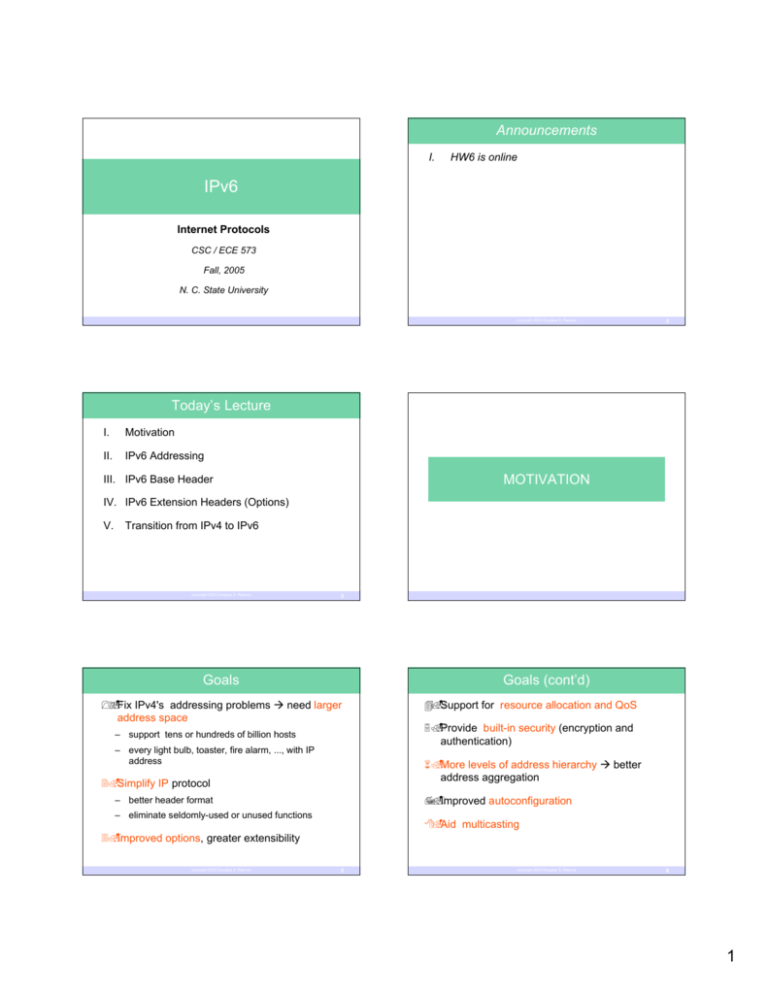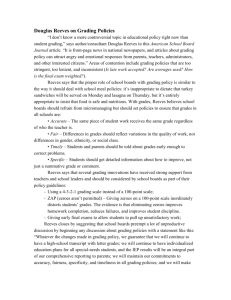Announcements Today's Lecture MOTIVATION Goals Goals (cont'd)
advertisement

Announcements I. HW6 is online IPv6 Internet Protocols CSC / ECE 573 Fall, 2005 N. C. State University copyright 2005 Douglas S. Reeves 2 Today’s Lecture I. Motivation II. IPv6 Addressing MOTIVATION III. IPv6 Base Header IV. IPv6 Extension Headers (Options) V. Transition from IPv4 to IPv6 copyright 2005 Douglas S. Reeves 3 Goals Goals (cont’d) Fix IPv4's addressing problems need larger address space – support tens or hundreds of billion hosts – every light bulb, toaster, fire alarm, ..., with IP address Support for resource allocation and QoS Provide built-in security (encryption and authentication) More levels of address hierarchy better address aggregation Simplify IP protocol – better header format Improved autoconfiguration – eliminate seldomly-used or unused functions Aid multicasting Improved options, greater extensibility copyright 2005 Douglas S. Reeves 5 copyright 2005 Douglas S. Reeves 6 1 History • IETF call for white papers on IPng (RFC 1550, 1993) – 21 proposals, 7 serious ones IPv6 ADDRESSING • Full spec: RFC2460 (1998) copyright 2005 Douglas S. Reeves 7 Address Space (RFC 3513) Hexadecimal Colon Notation • IPv6 addresses = 128 bits • 340,282,366,920,938,463,463,374,607,431,768,211,456 addresses – 665,570,793,348,866,943,898,599 hosts per square meter of the earth’s surface! • Hierarchical assignment – somewhat inefficient use of bits, but very helpful for administration and routing • 15% of address space currently allocated, 85% reserved for future use copyright 2005 Douglas S. Reeves 9 Hexadecimal Colon Notation (cont’d) 10 Categories of Addresses • Can also use dotted-decimal style • Unicast: defines a single entity (host, etc.) – e.g., • Multicast: defines a group of entities 253.236.186.152.0.116.0.0.0.0.0.15.0.0.255.255, or 253.236.186.152.0.116::15.0.0.255.255 – may or may not share the same address prefix – e.g., 0:0:0:0:0:0:128.10.2.1, or ::128.10.2.1 • Can use “/” notation to indicate the length of the address – e.g., 12AB::CD30:0:0:0:0/60 = 12AB00000000CD3 copyright 2005 Douglas S. Reeves copyright 2005 Douglas S. Reeves 11 – may or may not be connected to same physical network – packet must be delivered to each member of the group copyright 2005 Douglas S. Reeves 12 2 Categories of Addresses (cont’d) Address Structure (RFC 3513) • Anycast: defines group of entities having same address prefix – packet should be delivered to just one member of the group ("nearest," "most easily accessible," …) Prefix 0…0 (128 bits) 0…01 (128 bits) 1111 1110 10 – e.g., a group of servers offering the same service – allocated from same space as unicast addresses Address Type Unspecified Loopback address Link local address 1111 1110 11 Site local address 1111 1111 Multicast address (everything else) Global Unicast copyright 2005 Douglas S. Reeves 13 copyright 2005 Douglas S. Reeves Unspecified and Loopback Addresses Multicast Addresses copyright 2005 Douglas S. Reeves copyright 2005 Douglas S. Reeves 15 Local Addresses 10 • These addresses can be reused at each organization, i.e., represent a private address space 54 All 0s 64 • Packets with such addresses can only be routed locally INTERFACE ID – Link-local cannot be propagated outside the same physical network Site local address 10 54 1111 1110 11 16 Local Addresses (cont’d) Link local address 1111 1110 10 14 • used for autoconfiguration, … Subnet ID – Site-local cannot be propagated outside organizational boundaries 64 INTERFACE ID copyright 2005 Douglas S. Reeves 17 copyright 2005 Douglas S. Reeves 18 3 IPv4 Addresses (inside IPv6 Addresses) Mapping Ethernet MAC Addresses to Interface IDs 24 bits 24 bits cccccc0gcccccccccccccccc manufacturer’s extension FFFE16 cccccc1gcccccccccccccccc 1111111111111110 24 bits manufacturer’s extension 16 bits 24 bits 64 bit interface ID portion of IPv6 address copyright 2005 Douglas S. Reeves 19 copyright 2005 Douglas S. Reeves 20 IPv6 Datagram Format IPv6 BASE HEADER copyright 2005 Douglas S. Reeves IPv6 Base Header 22 Header Fields • Payload Length Traffic Class – 40 header bytes no longer counted as part of length Flow Label – 16 bits: payload length < 64K (includes extensions) • Next Header: type of the next header – optional headers may follow – last header points to higher-layer protocol (TCP, UDP) copyright 2005 Douglas S. Reeves 23 copyright 2005 Douglas S. Reeves 24 4 Header Fields (cont’d) Flow Label • Allows source and destination(s) to set up a “pseudoconnection” • Hop Limit – name reflects the way the TTL field in IPv4 is used – still experimental • Version: always 6 – an attempt to have it both ways: the flexibility of datagram network, and the guarantees of a virtual circuit network – useful during transition from IPv4 • Checksum gone! – rely on lower layers for header protection, and higher layers (transport) for payload protection – multiple flows (audio, video, graphic windows, etc.) • Traffic Class – a flow may comprise a single or multiple TCP connections – Same interpretation as DiffServ DSCP field copyright 2005 Douglas S. Reeves • Flow: uniquely identified by source, destination, flow label 25 copyright 2005 Douglas S. Reeves 26 IPv4 ↔ IPv6 Header Comparison Flow Label (cont’d) • Router's point of view: packets with non-zero flow label require special treatment – router tables specify treatment – requirements and reservations must be negotiated ahead of time copyright 2005 Douglas S. Reeves 27 copyright 2005 Douglas S. Reeves 28 Extension Headers • Fixed Base Header followed by optional Extension Headers IPv6 EXTENSION HEADERS (OPTIONS) – intermediate routers seldom need to process all the extension headers • IPv6 Extension Headers similar to IPv4 Options copyright 2005 Douglas S. Reeves 30 5 Extension Headers (cont’d) Extension Header Types • Compromise between… – generality: must include mechanisms for source routing, etc. – efficiency: most datagrams do not use all mechanisms • Next Header field helps in parsing the datagram • 6 extension headers defined copyright 2005 Douglas S. Reeves copyright 2005 Douglas S. Reeves 31 Extension Header Format 32 Fragmentation and Reassembly • Fragmentation header – Fragment Offset – Datagram Identification – MF flag • Destination performs reassembly (as in IPv4) copyright 2005 Douglas S. Reeves 33 Fragmentation and Reassembly (cont’d) copyright 2005 Douglas S. Reeves 34 IPv6 Fragmentation Example • Only source may do fragmentation – end-to-end no fragmentation at intermediate routers – source must perform path MTU discovery or use guaranteed minimum MTU of 1280 bytes • If a route change requires smaller fragments… – new type of ICMPv6 error message generated – source does new MTU discovery copyright 2005 Douglas S. Reeves 35 copyright 2005 Douglas S. Reeves 36 6 Source Routing Source Routing Header • Routing Extension Header allows up to 24 intermediate addresses – loose routing initially defined Next Header • Ultimate destination address not in Base Header; instead, it’s the last address in the Routing Header Addresses Left First Address Second Address – Base Header destination address is address of first router in path • Destination node required to reverse routes in a packet containing a routing header when replying to sender copyright 2005 Douglas S. Reeves Header Routing Type Length Reserved 37 Source Routing Example Last Address copyright 2005 Douglas S. Reeves 38 IPv6 Security • Basically IPSec as an extension header copyright 2005 Douglas S. Reeves 39 Hop by Hop Extension Headers copyright 2005 Douglas S. Reeves 40 Hop-by-Hop Extension (cont’d) • Source passes info to routers (like “router alert”) • If router does not support the option: first 2 bits of Type field indicate whether to… • Jumbograms: datagrams 64KB – 4GB in size – extension header specifies length, Payload Length in base header not used 1. skip option 2. discard packet but do not send ICMP error message 3. discard and send ICMP error message to source • Third bit specifies whether field is mutable (i.e., replace with zeros for authentication purposes) copyright 2005 Douglas S. Reeves 41 copyright 2005 Douglas S. Reeves 42 7 Other Protocols Affected by IPv6 Other Protocols Affected by IPv6 (cont’d) • ARP/RARP eliminated – MAC address mapped directly into 64-bit Interface ID field – e.g., Ethernet 48-bit address maps as: 24 bits, 16 bit padding (0xFFFE), 24 bits • IGMP eliminated – Group membership Query, Report, and Termination messages are added to ICMPv6 • DNS support for IPv6 addresses – new AAAA resource record copyright 2005 Douglas S. Reeves 43 copyright 2005 Douglas S. Reeves 44 Serverless Auto Configuration • Host generates link-local address, sends Router Solicitation • Router responds with Router Advertisement TRANSITION FROM IPv4 TO IPv6 – what default router to use – whether to use DHCP – prefixes to use for site-local and global addresses – may include a “lifetime” for prefixes; allows renumbering of networks copyright 2005 Douglas S. Reeves 45 IPv4 IPv6 Transition Transition Strategies (RFC 2893) • How much has IPv6 been deployed? • Some reasons why IPv4 has lasted longer than expected – CIDR – NAT (network address translator) – DHCP: improved ability to configure IPv4 addresses copyright 2005 Douglas S. Reeves 47 copyright 2005 Douglas S. Reeves 48 8 Dual Stack Tunneling • Allows packets between IPv6 hosts to pass through an IPv4 region • Host has complete support for both IPv4 and IPv6 – encapsulate IPv6 packets within IPv4 headers • Automatic tunneling: IPv4 tunnel endpoint determined from IPv4 address embedded in IPv4-compatible destination address of IPv6 packet – only end-hosts involved copyright 2005 Douglas S. Reeves 49 Tunneling (cont’d) copyright 2005 Douglas S. Reeves 50 Configured Tunneling (IPv6 over IPv4) • Configured tunneling: IPv4 tunnel endpoint determined by configuration info at the encapsulating node – routers translate headers copyright 2005 Douglas S. Reeves 51 Header Translation 52 Header Translation (cont’d) • Sender wants to use IPv6, but destination only understands IPv4 • Problem: TCP/UDP layer at destination verifies address with checksum of pseudo header – solution: 1's complement checksum of IPv4 address and IPv6 encoding identical • Translation needed: special translator nodes – i.e., changing the address has no effect • IPv4 nodes that do not support IPv6: ::FFFF:128.10.2.1 copyright 2005 Douglas S. Reeves copyright 2005 Douglas S. Reeves 53 copyright 2005 Douglas S. Reeves 54 9 Summary • Next Lecture IPv6 provides a number of new capabilities and improvements • Mobile IPv6 – most visible/important: larger addresses – Other: simplify IPv4, more extensible, more capabilities • • IPv6: needed, but when? Transition taking a lot longer than expected – but available in most desktop OSes now – required by DoD – basis for mobile IP (next gen cell phones) copyright 2005 Douglas S. Reeves 55 copyright 2005 Douglas S. Reeves 56 10






